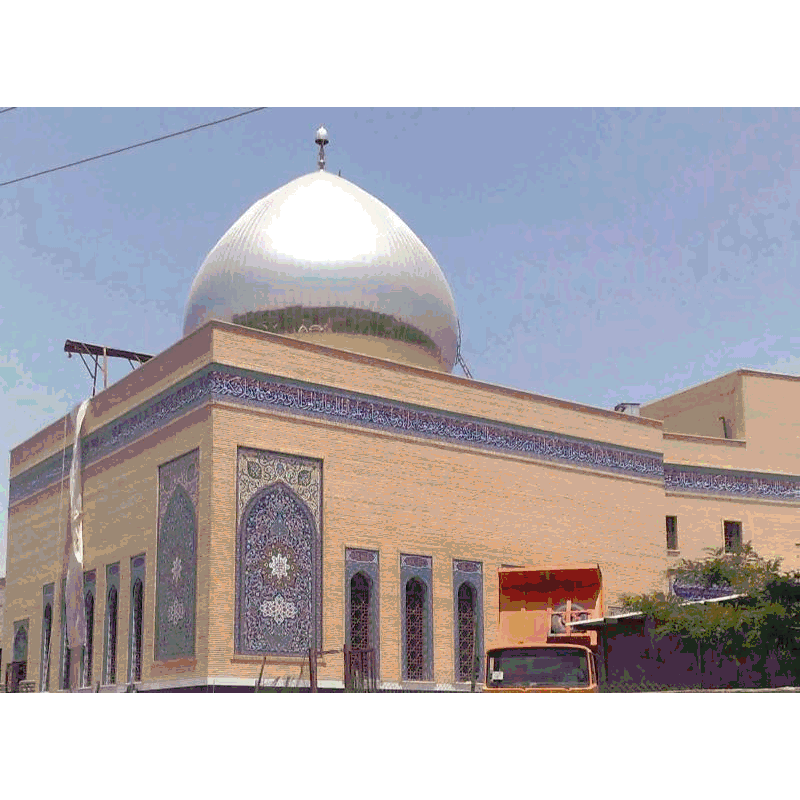Post by Caliph on Dec 22, 2014 9:41:24 GMT

Mosque (msk) (KEY) , building for worship used by members of the Islamic faith. Muhammad’s house in Medina (A.D. 622), with its surrounding courtyard and hall with columns, became the prototype for the mosque where the faithful gathered for prayer.
Structure
The basic elements of a mosque are a place large enough for the congregation to emble, especially on Friday, the Muslim sabbath, and orientation so that the faithful may pray facing in the direction of the holy city of Mecca. The wall facing Mecca is called the qibla wall and is marked by a mihrab, which usually takes the form of a decorated niche. In later ages mihrabs became quite elaborate; they are decorated with wooden fretwork in Morocco, with carved and pierced marble in Syria and Iraq, and with lusterware tiles bearing quotations from the Qur’an in Iran.
A mosque usually includes a number of distinctive elements: a mimbar (or minbar), a pulpit that is entered by a flight of steps and stands next to the mihrab; a maqsura, an enclosed space around the mihrab, generally set apart by trellis screens, in which the caliph, sultan, or governor prays; a minaret, a tower, usually built at one or more corners of the mosque, from which the call to prayer is sounded; a sahn, a courtyard, surrounded by riwaqs, colonnaded or arcaded porticoes with wells or fountains for the necessary ablutions before prayer; and space for a madrasa, a school that often includes libraries and living quarters for teachers and pupils.
All the great mosques are resplendent with elaborate decorations, but the prohibition against imitating God’s works by creating living forms is always obeyed. Decorations are abstract, and geometric plant forms are so distant from their originals as to be unrecognizable.
Representative Mosques
An early mosque, the Dome of the Rock (691–692) in Jerusalem, is a unique architectural monument. It follows an octagonal Byzantine plan, with a dome entirely of wood. Domed mosques, however, were not commonly built until some six centuries later. The mosque of 879 near Fustat was built by Ibn Tulun of stucco and brick and ornamented with floral reliefs in stucco.
In the 14th cent. a Persian innovation appeared, in which four iwans—monumental facades with pointed vaults—were arranged around a central courtyard. The arm toward Mecca, wider and deeper than the others, contains the mihrab. A fine example of the form is the Great Mosque (1356) of Sultan Hasan at Cairo. The structure at Córdoba, Spain, represents a departure from the four-iwan style. This hypostyle mosque was begun in 780 and enlarged in the 10th cent. until its prayer hall, with 16 rows of columns and arches, occupied an area greater than that of any Christian church. The Cathedral of Córdoba was built in 1238 right in the middle of the mosque area.
Mosques of Persia inherited the Sanian vaulting tradition and surface decoration with resplendent ceramics. They thus possess a distinctive character in their pointed onion-shaped domes, lofty pointed portals, and magnificent polychrome tiles. In the 15th and 16th cent. the colonnaded prayer halls were replaced by large, square, domed interiors, sometimes surrounded by lower vaulted side aisles, as in the Blue Mosque at Tabriz (1437–68). This structure, of essentially Byzantine plan, is sheathed with incomparable blue ceramics. The imperial mosque at Isfahan (1585–1612) had four impressive porticoes on the court, and its main prayer hall, crowned by an onion-shaped dome and with a porch having an enormous pointed arch flanked by slender minarets, represents the climax of Persian mosque design.
When the Turks took Constantinople (1453) they used the great Byzantine church Hagia Sophia as a mosque, and later employed it as a model for Islamic religious structures. To the great open plan of Hagia Sophia with its dominant dome they added smaller domes, half domes, buttresses, and minarets and used Persian tiles and rather garish painted decoration for interiors. Thus they achieved at Constantinople such superb monuments as the mosque (1550–57) of Sulayman I, the Magnificent, by the architect Sinan, and the huge Ahmediyeh mosque (1608–14) of Ahmed I.
Indian mosques betray their Persian origin in the prevalence of onion-shaped domes, round minarets, and great portals with pointed arches, although the traditional Persian tile sheathing is largely restricted to interiors. The use of stone and marble for exteriors, however, lends them a solid monumentality rarely seen in other Muslim styles, while colored stones inlaid against the white marble add touches of vivid beauty. During the Mughal dynasty, particularly under the brilliant reign of Shah Jahan (1627–58), mosques of surprising grandeur were erected. Among the finest Mughal examples are the huge mosque with its superb domes and entrance at Fatehpur Sikri (1556–1605); the three-domed Pearl Mosque at Agra (1646–53), famous for its simple plan and delicate inlays; and the Jama Masjid [great mosque] at Delhi, the largest in India.




 Happy Nowrooz
Happy Nowrooz



